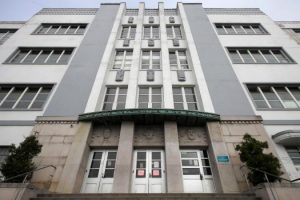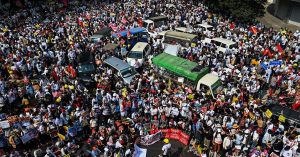Gov. Andrew M. Cuomo on Monday visited one of the largest mass COVID-19 vaccination sites that will be operating in the state ahead of its Wednesday reopening, a center based at Medgar Evers College in Brooklyn that will inoculate 3,000 people a day.
A similar site is scheduled to open Wednesday at York College in Queens as part of the state’s efforts to vaccinate more Blacks and Latinos, who are among the groups hardest-hit by the virus.
The sites, run jointly with the federal government, will operate from 8 a.m. to 8 p.m.
“COVID exposed low tide in America. It revealed the unacceptable disparities and injustices that have plagued our society for decades — and New York is doing everything it can to reverse those trends in the vaccination process,” Cuomo said Monday.
To help ensure access to the vaccine among minorities, the sites will be open for the first week to people living in certain ZIP codes where infection levels are high and vaccination rates are low. Later, they will be open to any residents of those boroughs.
Cuomo also said the MTA is launching a pilot program to expand bus service in Brooklyn and Queens so that residents can more easily travel to the sites.
The state is also enlisting the help of faith leaders to convince Blacks and Latinos to take the vaccine and “to dispel rumors and myths about the vaccine itself.”
The faith leaders will take part in phone banks calling residents to encourage people to get the shots.
New York runs other mass vaccination sites at locations including Jones Beach and Stony Brook University. Nassau and Suffolk counties run their own sites at locations including Suffolk County Community College and Nassau County Community College.
Cuomo made the announcement in Brooklyn as levels of virus infection are declining statewide, although New York continues to struggle to get enough vaccines to inoculate the population rapidly.
The state has seen encouraging trends recently in declining positivity rates and hospitalization levels.
In the region, Northwell Health on Monday said the number of COVID-19 patients in its hospitals dipped below 1,000 for the first time this year.
The largest health system in the state said it has 998 COVID-19 patients at the 19 hospitals it owns and operates. Northwell said it dipped under 1,000 over the weekend for the first time since Dec. 20.
Northwell, based in New Hyde Park, registered a 9% drop in hospitalized cases in the last week alone.
NYC: Catching up on vaccination delays
Last week’s snowstorms severely disrupted New York City’s COVID vaccine program, at one point bringing the city’s supply of first doses down to less than 1,000, Mayor Bill de Blasio said Monday during his daily news conference.
The city will receive last week’s doses — amounting to about 170,000 — in the coming days while an equal number will arrive later in the week to cover the final week of February, he said. City officials expect the vaccine supply to modestly increase next month.
“We lost a full week in our vaccination,” de Blasio said, adding that the city nonetheless surpassed 1.5 million first doses administered. “But this will not stop us from reaching our goal of vaccinating 5 million New Yorkers by June.”
The mayor Monday also appointed Lorraine Grillo, the chief executive of the city’s School Construction Authority and the commissioner of the Department of Design and Construction as the city’s new COVID Recovery Czar. Grillo, de Blasio said, will coordinate the recovery efforts across all government agencies, holding weekly war room meetings among deputy mayors.
“Lorraine will cut through bureaucracy, coordinate across all agencies, and reach out to nonprofit and private partners to make sure our recovery is felt in every borough, every neighborhood, and every block,” de Blasio said.
Grillo, a Queens native who played a central role in the city’s recovery from Superstorm Sandy and with the Pre-K for All program, said she plans to rely on women and minority-owned businesses to jump start the recovery effort.
“I will cut through noise and get things done,” Grillo said. “I will fight to make sure our recovery is felt in every borough and in every neighborhood.”
With Robert Brodsky and David Reich-Hale
GETTING COVID-19 VACCINES
Who qualifies for COVID-19 shots?
New York State expanded the list of qualifying residents to encompass people 65 years of age and older as well as others with underlying conditions that put them at higher risk. The state had previously expanded its vaccination program to include essential workers and people 75 years of age and older in addition to health care workers and nursing home residents and staff, among others. The supply of vaccines is limited even as more groups are added. Hospitals will continue to prioritize unvaccinated members of the first phase, focusing largely on health care workers. The following are the qualifying categories, as revised on Feb. 9.
Group in Phase 1A
The state said about 2.1 million state residents belong in this group, including:
- Health care workers at hospitals who interact with patients.
- Residents and staff at nursing homes and assisted living facilities.
- Dentists, psychologists and others deemed health care workers with direct contact with patients.
- Employees of Federally Qualified Health Centers.
- EMT volunteers and staff.
- Coroners, medical examiners, some funeral workers.
- Staff and residents of state facilities for people with developmental disabilities, mental health care and addiction services.
- Employees at urgent care centers.
- Individuals administering COVID-19 vaccines, including local health department staff.
- Staff at ambulatory centers.
- Home care and hospice workers.
- Residents and staff at other congregate care facilities.
Group in Phase 1B
The state estimated about 3.2 million residents belong in this group, including:
- People 75 years of age and older.
- Teachers and education workers, including in-person college instructors, substitute teachers, student teachers, school administrators, paraprofessional staff, support staff, contractors in schools and bus drivers.
- First responders, including police; firefighters; state police; sheriff’s offices; county, town and village police departments, and other law enforcement offices.
- Public safety workers, including dispatchers and technicians.
- Public transit workers, including airport, railroad, subway, bus, ferry and Port Authority employees.
- Corrections officers.
- Other sworn and civilian personnel, such as court and peace officers.
- Grocery store workers dealing with the public.
- Individuals living in homeless shelters.
Following federal recommendations:
Added at the discretion of local governments:
- Taxi drivers.
- Restaurant workers.
- Residents of facilities for developmentally disabled people.
SOURCE: New York State, Northwell Health.
Check back for updates on this developing story. Sign up for COVID-19 text alerts at newsday.com/text.



















